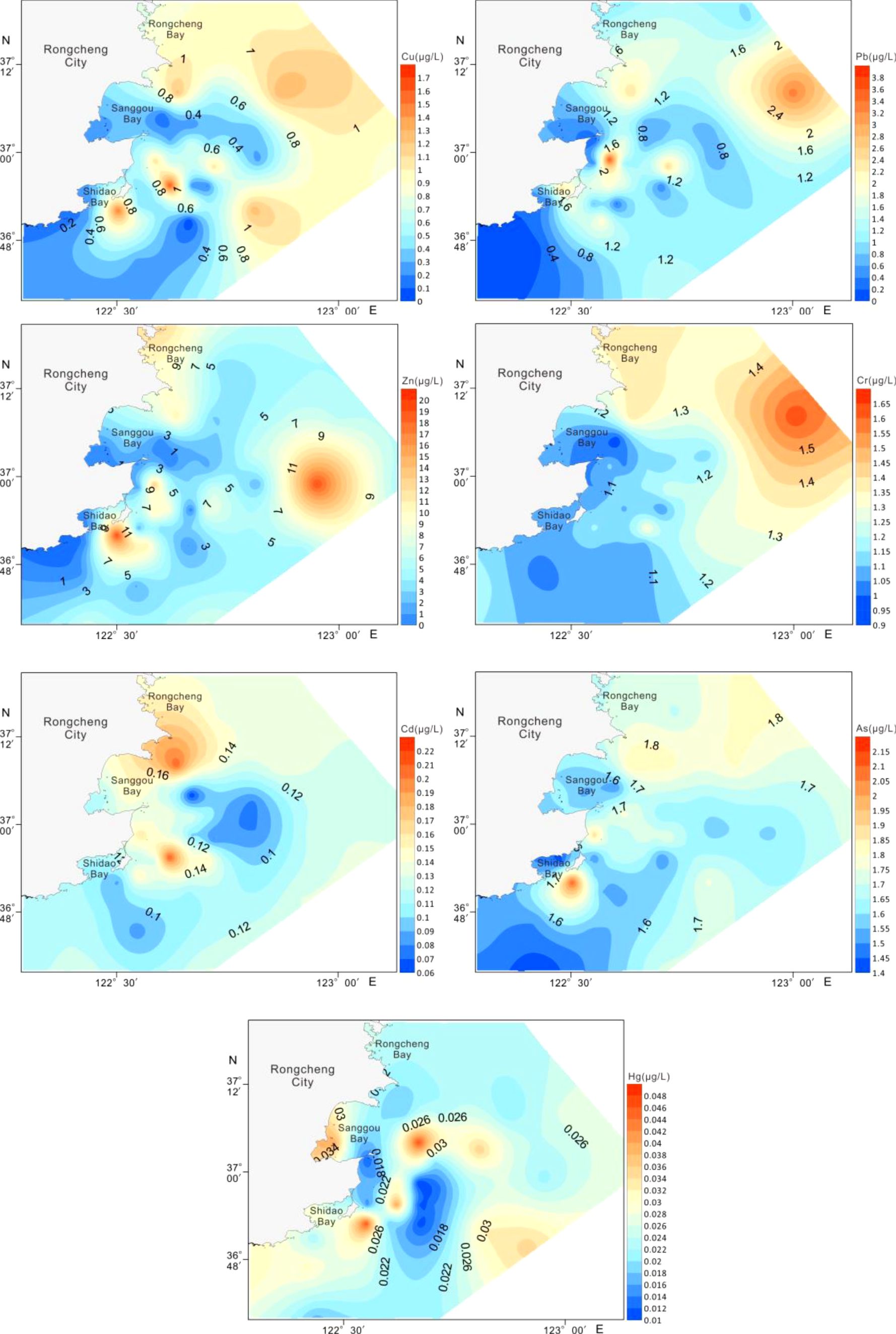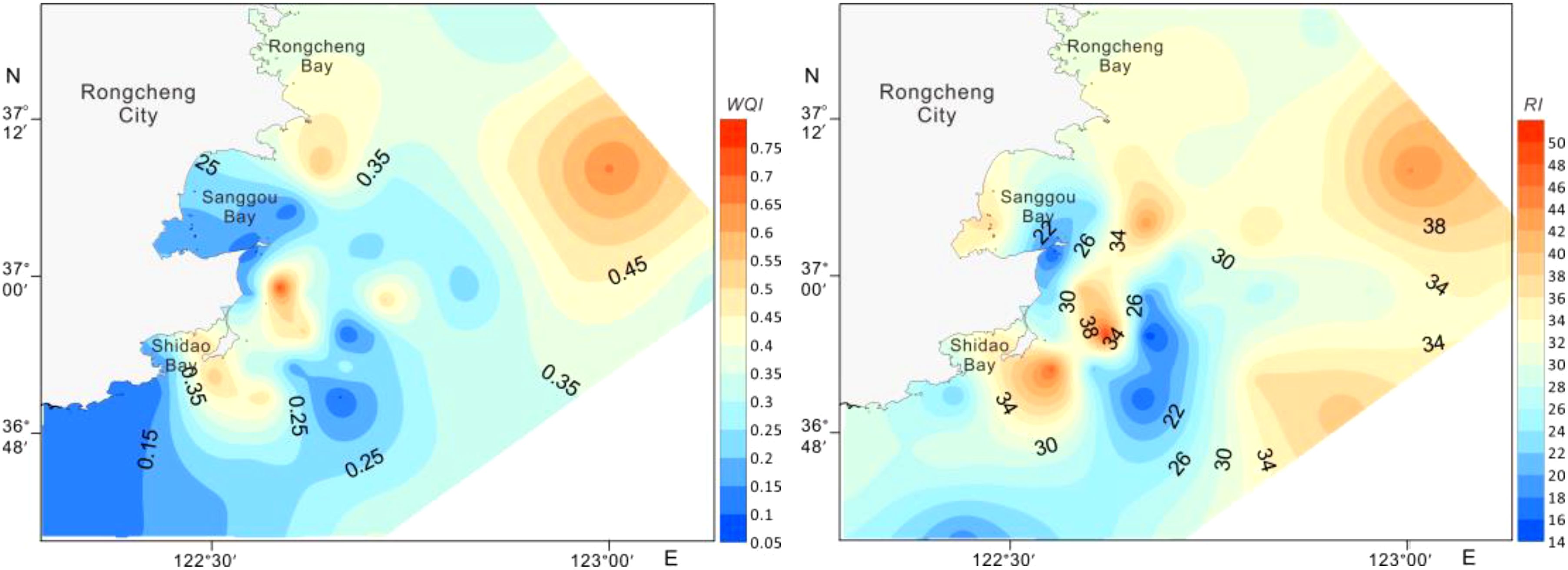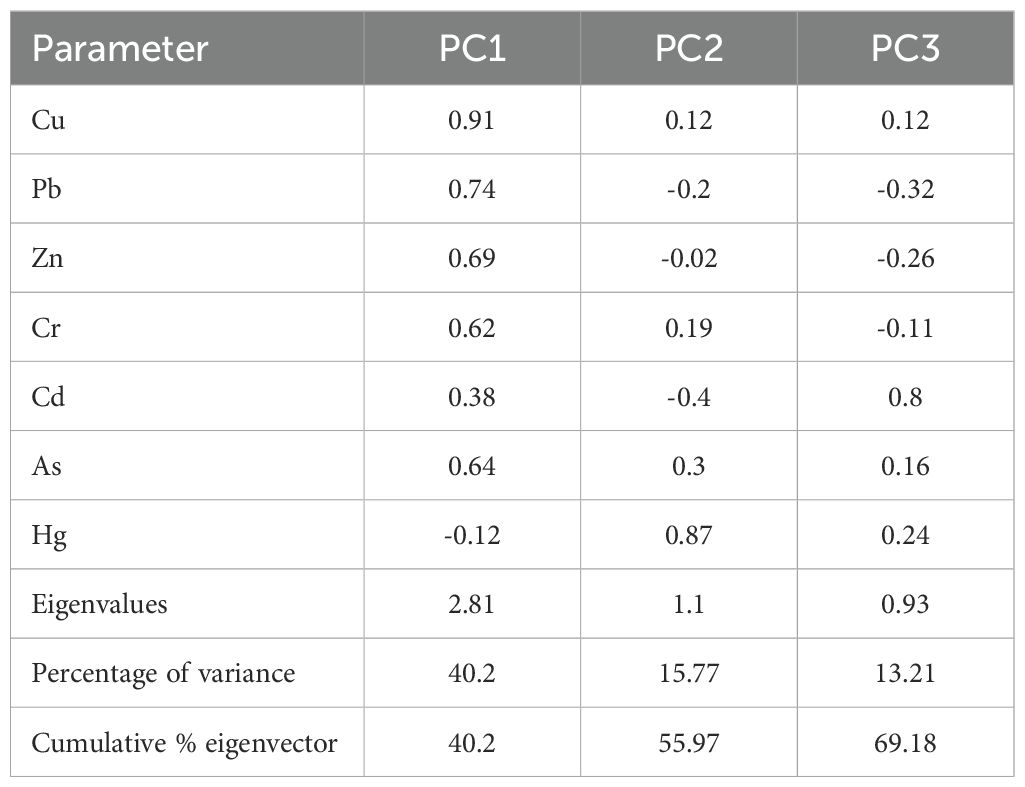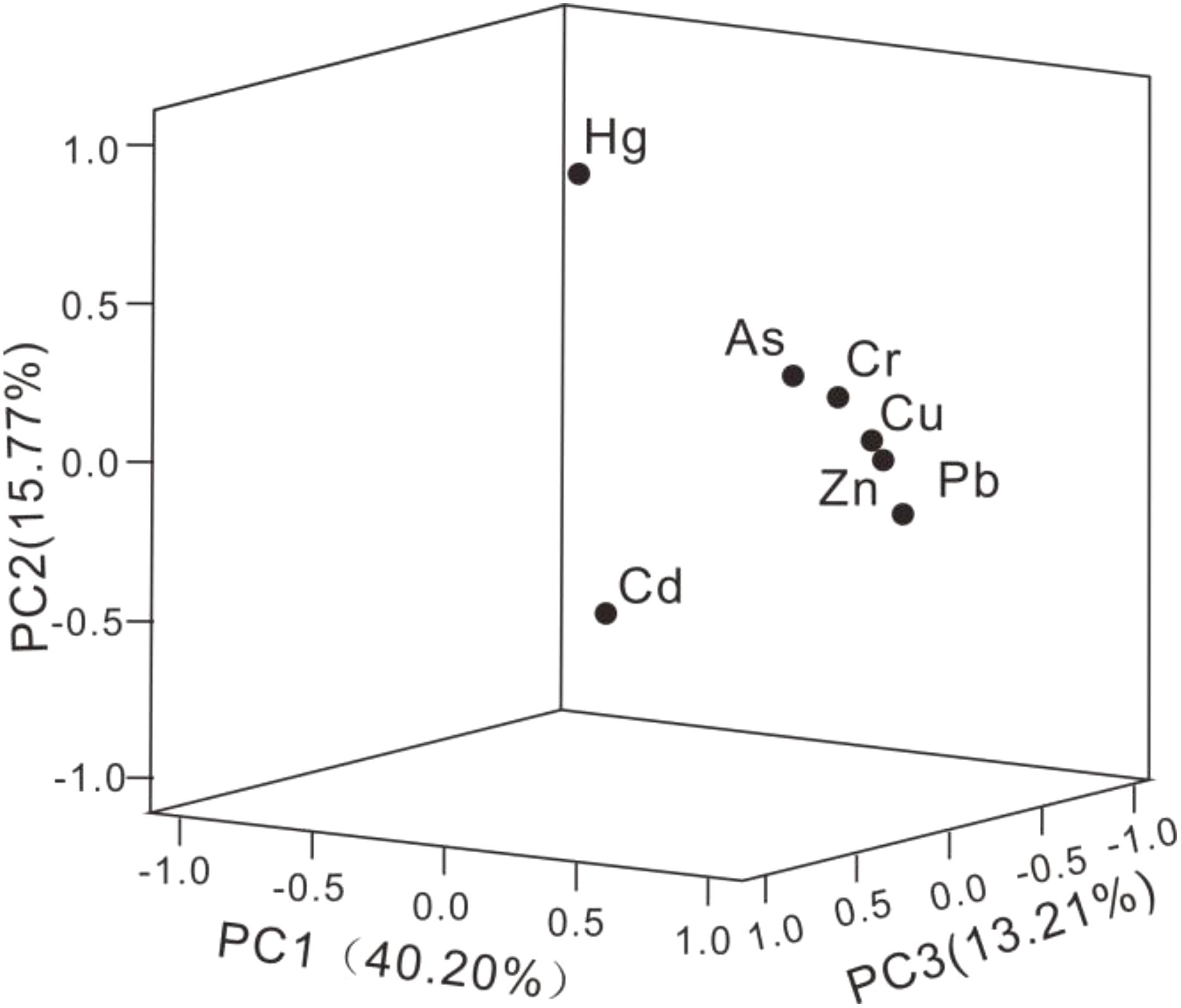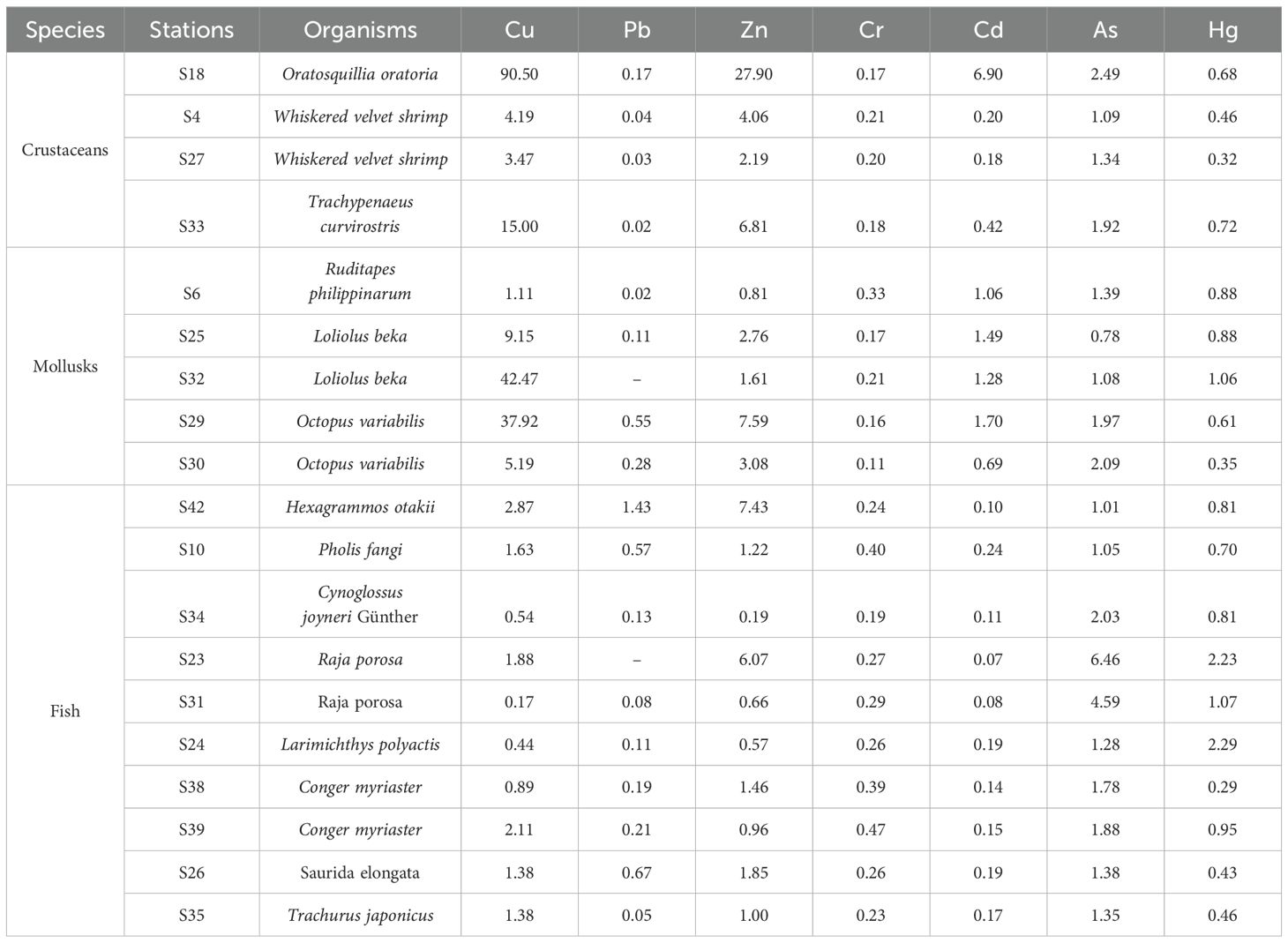- 1First Institute of Oceanography, Ministry of Natural Resources, Qingdao, China
- 2Research Center for Ecological Environment, Zhejiang Institute of Hydrogeology and Engineering Geology, Ningbo, China
- 3Qingdao Institute of Marine Geology, China Geological Survey, Qingdao, China
- 4Huangdao Branch, Qingdao Geotechnical Investigation and Surveying Research Institute, Qingdao, China
Marine ecosystems in coastal regions are increasingly threatened by anthropogenic inputs of heavy metal(loid)s, with significant implications for environmental health. This study evaluates the spatial characteristics and ecological risks of heavy metal(loid)s in the Rongcheng nearshore environment through comprehensive analysis of surface water samples and marine organisms collected during summer 2017. Analytical data revealed that seawater concentrations for most measured elements complied with Class I standards (GB 3097-1997), with lead being the sole exception showing moderate contamination at specific sampling locations. Ecological risk assessment through integrated indices demonstrated generally favorable conditions, with both water quality parameters and potential ecological risk values falling within acceptable ranges. Source apportionment analysis differentiated the heavy metal(loid)s into two distinct groups: Cu, Pb, Zn, Cr and As predominantly originating from human activities, whereas Hg and Cd derived mainly from geological processes. Notably, despite typically low aqueous-phase concentrations, these elements demonstrate significant biomagnification potential through trophic transfer processes. Tissue analysis of marine organisms showed compliance with biological quality standards for most elements, except for localized exceedances of Cu and As. Bioaccumulation factors consistently above unity across multiple species highlight considerable seawater-to-organism transfer efficiency. These findings underscore the importance of maintaining seawater quality standards to mitigate potential impacts on marine food webs and human seafood consumption.
1 Introduction
Heavy metal(loid)s are a class of toxic pollutants that are persistent, bioaccumulative, and pose significant threats to human health and the environment (Alyazichi et al., 2015; Duan et al., 2021; Madadi et al., 2023). They can enter the marine ecosystem through various pathways, including surface runoff, coastal industrial and agricultural wastewater, and urban sewage discharge (Leung et al., 2021; Avvari et al., 2022). Once in the ocean, heavy metal(loid)s can transfer along the food chain, leading to bioaccumulation and posing further risks to marine ecological environments (Rubio et al., 2000; Qiu et al., 2019). Consequently, the issue of heavy metal(loid) pollution in marine environments has become a focal point of research (Caccia et al., 2003; Xiang et al., 2023).
Rongcheng City, located at the easternmost tip of the Shandong Peninsula, features a favorable natural environment along its coastal waters, characterized by a flat seabed, high primary productivity, and abundant aquatic resources, making it an ideal region for aquaculture development (Sun et al., 2021). The shallow coastal aquaculture industry in Rongcheng is highly developed, serving as a major seafood production base for the city and a significant semi-enclosed marine aquaculture demonstration area in northern China. Therefore, conducting an assessment of heavy metal(loid) pollution and its ecological impacts in the coastal waters of Rongcheng holds dual value for both aquaculture production activities and ecological environmental protection (Yue et al., 2024). Wu et al. (2017) investigated the concentrations of seven heavy metal(loid)s in surface sediments from the waters adjacent to Ailian Bay in Rongcheng. They analyzed the content and spatial distribution of these heavy metal(loid)s, as well as the potential ecological risks based on the Hakanson index. The results indicated that the concentrations of heavy metal(loid)s in the surface sediments of the study area met the first-class sediment quality standards, suggesting good sediment quality. The potential ecological risk index revealed that the overall ecological risk level of heavy metal(loid)s in the sediments was moderate. Specifically, Cd at all sampling sites posed a medium potential ecological risk, while 50% of the sampling sites for Hg also indicated a medium potential ecological risk, with Cd and Hg identified as the primary ecological risk factors.
Recent investigations into heavy metal(loid) contamination in coastal environments have predominantly emphasized their spatial distribution, origin identification, and pollution evaluation in surface sediment (Wu et al., 2017; Wang et al., 2022, 2023). Nevertheless, the biogeochemical cycling of these contaminants in the water column and marine organisms of Rongcheng’s coastal ecosystem remains insufficiently explored. From a hydrodynamic perspective, suspended particulates efficiently scavenge dissolved heavy metal(loid)s from seawater, facilitating their deposition into benthic sediments. This process is reversible, however, as sediment-bound contaminants can re-enter the water column through biogenic mixing and physical resuspension mechanisms. The aquatic environment thus functions as a dynamic interfacial system mediating metal transport pathways. Of particular ecological concern is the bioaccumulation potential of these elements. Riverine discharges and atmospheric deposition introduce heavy metal(loid)s into marine systems, where they undergo trophic transfer via two primary mechanisms: direct uptake by primary producers and biomagnification through successive trophic levels. These persistent contaminants exhibit high affinity for calcium-rich tissues and demonstrate remarkable metabolic stability within organisms, leading to progressive enrichment in higher consumers. This bioaccumulation pathway poses substantial human health risks, particularly for populations with high dietary reliance on contaminated seafood (Chatterjee et al., 2007).
The present study implements an integrated assessment framework to examine heavy metal(loid) contamination in Rongcheng’s coastal waters and associated organisms. Our objectives are: (1) to elucidate contaminant sources through multivariate analysis, (2) to quantify ecological risks using established indices, and (3) to inform the design of targeted remediation strategies for this vulnerable coastal ecosystem.
2 Materials and methods
2.1 Sample collection and analytical methods
46 surface seawater samples and 19 marine organisms were collected from Rongcheng coastal area in July 2017 (Figure 1). The sample collection, preservation, and transportation methods followed the ‘Specifications for Marine Surveys’ (GB/T12763-2007).
2.1.1 Seawater sample collection and processing
Subsurface seawater samples (0.5 m depth) were acquired using acid-cleaned plexiglass samplers, with rigorous pre-treatment protocols implemented to prevent contamination. For trace metal analysis (Zn, Cu, Cr, Cd, Pb), samples were stored in pre-rinsed polyethylene containers, whereas Hg and As required amber glass bottles due to their volatility. Immediate acidification was performed using ultrapure HNO3 (2 mL per 500 mL sample) for most metals, while H2SO4 served as the preservative for As and Hg speciation studies. All samples underwent vacuum filtration (0.45 μm glass fiber membranes) within 4 hours of collection, followed by dark refrigeration at 4°C prior to laboratory analysis (Lü et al., 2015).
The digestion protocol involved concentrated HNO3 (10 mL per 0.5 L sample) refluxing on a temperature-controlled hotplate (120°C) until a 10 mL residual volume was achieved. Digestates were then reconstituted to 25 mL with 1% HNO3 matrix solution and vortex-mixed for homogeneity. Parallel processing of certified reference materials (CRM) and procedural blanks accompanied each batch to monitor methodological artifacts (Yue et al., 2024).
2.1.2 Biological sampling methodology
Biological samples were collected using a single-vessel wing-equipped single-bag bottom trawl (40m×94m/49.3m) during daytime operations. Considering multiple factors including towing speed, towing direction, current direction, current speed, wind direction, and wind speed, the trawl was deployed at a distance of 2–4 nautical miles from the station. The towing speed was controlled at 3–4 knots, and the trawl was expected to reach the vicinity of the station after 1 hour of towing. Prior to deployment, the ship’s position was accurately determined. The timing of trawl deployment was marked by the moment when the towing line stopped being released and began to experience seabed traction. During towing, the trawl opening was maintained towards the station as much as possible while closely monitoring the dynamics of surrounding vessels and the trawling status of the survey vessel. In case of abnormal towing, the towing direction was adjusted or the trawl was immediately hauled in according to the situation. Before hauling, the ship’s position was accurately recorded again, and the timing of trawl hauling was defined as the moment when the trawl winch started reeling in the towing line. Re-trawling was conducted if severe net damage or significant reduction in catch occurred (Zhou et al., 2022).
After collection, biological samples were first subjected to species identification, with biological indicators such as body length and body mass recorded. Subsequently, the samples were classified, refrigerated, and transported to the laboratory for further analysis. Muscle tissues were extracted from fish pectoral fin, cephalopod head, crab claw, bivalve adductor, and gastropod. These tissues were washed with ultrapure water, placed into 10 mL centrifuge tubes, and stored frozen in a refrigerator. The digestion of biological samples followed the analytical methods specified in Pretreatment for Analysis of Heavy Metal(loid)s in Marine Sediments and Marine Organisms (HY/T132-2010). For each digestion cycle, 0.1 g of biological sample was weighed, and 9 mL of nitric acid and 3 mL of hydrogen peroxide were used as the digestion solution (Zhang et al., 2023).
2.1.3 Laboratory analytical procedures
Flameless atomic absorption spectrophotometry was used to measure the levels of Cu, Pb, Zn, and Cd in seawater. Flameless atomic absorption spectrophotometry was used to determine the levels of Cu, Pb, and Cd in biological samples, while flame atomic absorption spectrophotometry was used to determine the levels of Zn. A Varian 240 FS atomic absorption spectrometer from the USA was the device in use. An atomic fluorescence photometer (XGY1011A) was used to measure As and Hg. The detection limits of Cu, Pb, Zn, Cr, Cd for the Varian 240 FS atomic absorption spectrometer and As, Hg for XGY1011A atomic fluorescence photometer are 0.001, 0.01, 0.02, 0.1, 0.005, 0.05, and 0.001μg/L. The quantification limits of Cu, Pb, Zn, Cr, Cd, As, and Hg are 0.003, 0.02, 0.04, 0.3, 0.015, 0.15, and 0.003 μg/L. Analytical quality was ensured through blank reagent control, parallel sample analysis, and certified reference material validation. The accuracy of the analysis was validated using the certified reference materials (GBW080040, GBW080230, and GBW08308) obtained from the National Standard Reference Materials Center. The same analytical procedures applied to the samples were employed for the reference material to ensure consistency and reliability. The Cu, Pb, Zn, Cr, Cd, As, and Hg values of the certified material are 5 ± 0.4, 10 ± 0.6, 70 ± 3, 5 ± 0.4, 1 ± 0.06, 1 ± 0.04, and 0.48 ± 0.03 μg/L. Spike recovery rates for all elements were maintained within the range of 90%–110%. Ten percent of the samples were analyzed in triplicate, with relative standard deviations (RSDs) ranging from 0.05% to 2.5%, ensuring the reliability and reproducibility of the measurement results (Xiang et al., 2023).
2.2 Analytical assessment method
Spatial data visualization was achieved using Surfer 23.0 software for generating planar distribution maps, while statistical analyses including principal component analysis and pearson correlation analysis were performed using SPSS 27.0 (IBM Corp.). Microsoft Excel 2016 (Microsoft Corp.) was employed for preliminary data processing and descriptive statistical calculations.
2.2.1 Analytical methods for heavy metals in seawater
Single factor pollution index (Cf), water quality index (WQI), potential ecological risk index (RI), pearson correlation coefficient (PCC) and principal component analysis (PCA) were utilized to identify sources and evaluate heavy metal(loid) pollution risk.
The Cf is indicative of the pollution level of a single heavy metal(loid) in seawater. The WQI is widely applied in water quality assessments (Küikrer and Mutlu, 2019), with the capacity to transform complex water quality data into information that is comprehensible and utilisable by the public. Cf and WQI were calculated as follows (Equations 1, 2):
Where, Ci is the measured concentration of heavy metal(loid) i in seawater or organisms, Cs is the first-class standard concentrations of heavy metal(loid)s in Seawater Quality Standard (GB 3097-1997). Relationships between , RI, Cf, WQI and pollution level are shown in Table 1.
The RI assesses ecological risks by considering metal toxicity and background concentrations (Hakanson, 1980). It is calculated as (Equation 3):
Here, represents the contamination factor for the ith heavy metal, where and denote the measured concentration and geochemical background value, respectively. is the toxic response factor assigned to each metal. The ecological risk coefficients for heavy metals are as follows: Zn = 1, Cr = 2, Cu = 5, Pb = 5, As = 10, Cd = 30, and Hg = 40 (Hakanson, 1980). The RI aggregates the ecological risks of multiple heavy metals. Each metal’s ecological risk () is categorized into five levels: low (<40), moderate (40–79), considerable (80–159), high (160–319), and very high (≥320). Similarly, the RI is divided into four risk categories: low (RI < 105), moderate (105 ≤ RI < 210), significant (210 ≤ RI < 420), and very high (RI ≥ 420) (Xu et al., 2021).
2.2.2 Analytical methods for heavy metals in organisms
The single pollution index (Pi) and bio-accumulation factor (BAF) were used to evaluate heavy metal(loid) pollution risk.
In accordance with the “Marine Biological Quality” (GB18421-2001) standard, the single factor pollution index method was employed to assess the extent of heavy metal(loid) contamination in marine organisms and the calculation formula is as follows (Equation 4):
The single pollution index (Pi) was calculated using the measured concentration of pollutants (Ci) and the evaluation standard or reference value of the pollutants (Si). The evaluation criteria for heavy metal(loid)s in crustaceans, mollusks (except shellfish), and fish were based on biological quality standards set out in the “concise regulations for comprehensive survey of coastal and sea surface resources in China.” The relevant standard values are listed in Table 2. Currently, there are no clear grading standards in China, and it is commonly accepted that when Pi is <1.0, the biological mass meets the standard. However, when Pi is >1.0, the biological mass exceeds the standard (Xavier et al., 2020).
BAF refers to the degree of enrichment of heavy metal(loid)s by organisms from the surrounding environment. In this paper, BWAF is used to represent the biological concentration coefficient of heavy metal(loid)s in seawater. The calculation formula is as follows (Equation 5):
Ci represents the concentration of heavy metal(loid)s in organisms (μg/g), Cw indicates the concentration of heavy metal(loid)s in seawater (μg/L). The choice of sampling seawater from 0.5 m below the surface and using bottom trawl for organisms is highly relevant to the BAF calculation. The surface - layer seawater at 0.5 m depth is where organisms at the lower trophic levels, which are the starting point of the food chain for the target organisms collected by bottom trawl, directly interact with the water. This layer contains the dissolved contaminants that can be taken up by these organisms. The bottom - trawled organisms are the ones that accumulate these contaminants over time. By using these two sampling methods, we can accurately measure the concentration of the target substances in both the source (seawater) and the target organisms. Our BAF calculation formula takes into account the concentration differences between these two compartments, ensuring that the result is correct. For example, in previous similar studies in Zhang et al., 2023 and Zhou et al., 2022, the same sampling depths for seawater and bottom - trawling for organisms were used, and the BAF results were consistent with the expected ecological trends.
3 Results and discussion
3.1 Concentrations of heavy metal(loid) in surface seawater
The contents of Cu, Pb, Zn, Cr, Cd, As and Hg in surface seawaters of Rongcheng coastal area ranged from 0.004 to 1.65, 0.07 to 3.73, 0.27 to 19.6, 0.97 to 1.64, 0.06 to 0.21, 1.41 to 2.11, and 0.01 to 0.05 μg/L (Table 3), respectively. The mean concentrations were 0.6, 1.2, 5.1, 1.2, 0.1, 1.7, and 0.02 μg/L, respectively. According to the water quality standard of seawater (GB 3097-1997), except for Pb, the content of all other elements conforms to the first class water quality standard (Table 1). The concentrations of Cu, Cr, and Hg in the Rongcheng coastal area were lower than those in Laoshan Bay (Wang et al., 2019), Laizhou Bay (Lü et al., 2015), and Dingzi Bay (Pan et al., 2014). However, the Pb and As concentrations in Rongcheng were significantly higher than those in the aforementioned areas. The concentrations of Zn and Cd in Rongcheng were higher than those in Laoshan Bay but lower than those in Dingzi Bay. Compared to Lianyungang offshore (Gao et al., 2025), the Rongcheng coastal area exhibited lower concentrations of Cu, Zn, and Cr, while Pb and As levels were higher. In contrast, the concentrations of Cd and Hg were similar between the two regions. When compared to Hangzhou Bay (Zhu et al., 2024), the Rongcheng coastal area showed lower concentrations of Cu, Zn, Cr, and Hg, but higher levels of Pb and As. The Cd concentration in Rongcheng was slightly higher than that in Hangzhou Bay. In comparison to the Agadir coastline (Azdem et al., 2024), the Rongcheng coastal area had significantly lower concentrations of all measured heavy metals, particularly Pb, Zn, Cd, and Hg, which were orders of magnitude lower in Rongcheng. Similarly, the heavy metal concentrations in Rongcheng were much lower than those in Bengal Bay (Achary et al., 2016) for all elements, except for As, which was not reported in Bengal Bay.
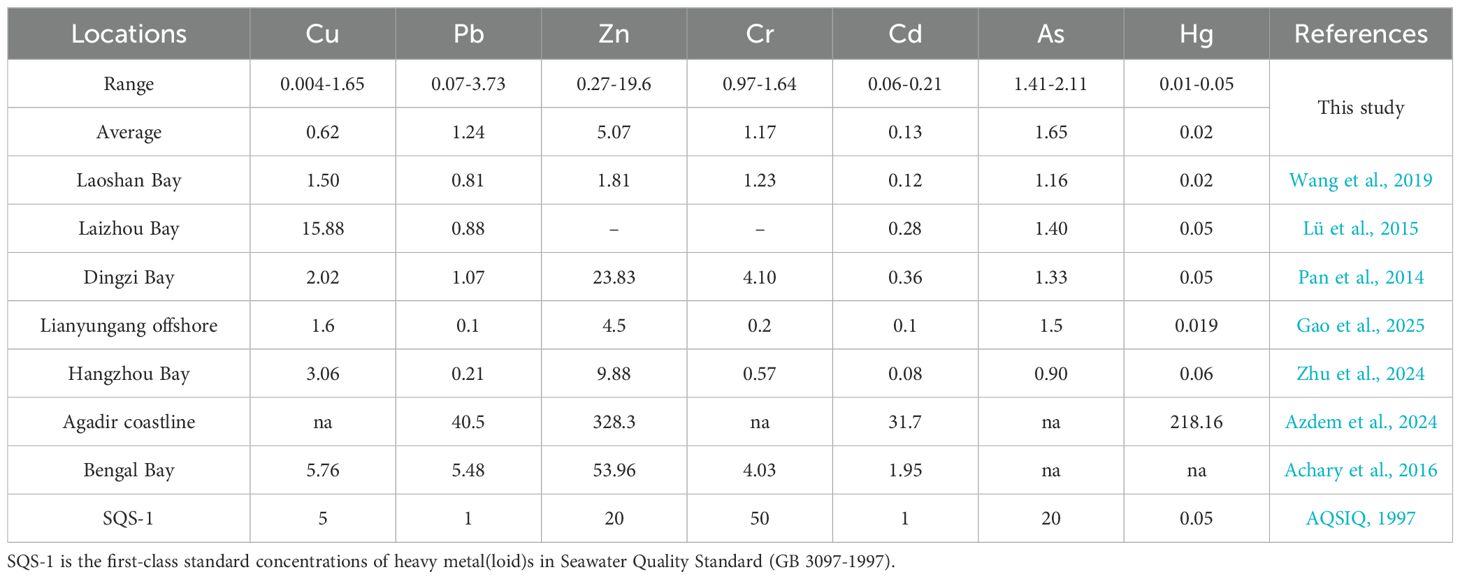
Table 3. Heavy metal(loid) concentrations in the surface seawater in Rongcheng coastal area (unit: μg/L).
Figure 2 shows the spatial distribution of heavy metal(loid)s in the surface seawaters in the study area. The distribution of Cu, Pb, Zn, and Cr were similar, with the high concentrations mainly appeared in the Rongcheng offshore area. The high concentrations of Cu, Zn, Cd, As, and Hg were also observed outside of the Shidao Bay.
3.2 Contamination and ecological assessment in surface seawaters
The Cf values for Cu, Pb, Zn, Cr, Cd, As, and Hg in the surface seawaters in Rongcheng coastal area ranged from 0.001 to 0.33, 0.07 to 3.73, 0.01 to 0.98, 0.019 to 0.033, 0.06 to 0.21, 0.07 to 0.11, and 0.2 to 0.94, respectively, with mean values of 0.12, 1.24, 0.25, 0.023, 0.13, 0.08, and 0.48, respectively (Table 4). Except for Pb, the Cf values of all other heavy metal(loid)s were less than 1, indicating these metal(loid)s were in low pollution level. The Cf values of Pb at 55% and 5% stations were 1–3 and greater than 3, respectively, showing medium and high level pollution (Figure 3). The WQI of each station in surface seawaters ranged from 0.09 to 0.74, which was less than 1, indicating that the seawater quality was in a clean state for overall heavy metal(loid)s during the investigation period (Ramadan et al., 2021).
Surface seawater analysis revealed a consistent hierarchy of metal(loid) risk coefficients: Hg exhibited the highest ecological risk potential, followed sequentially by Pb, Cd, As, Cu, Zn, and Cr (Table 4). Notably, all monitored elements demonstrated risk coefficients less than 40 across sampling stations, classifying them within the negligible ecological risk category according to Hakanson’s criteria. The RI showed spatial variability ranging between 15.02 and 50.43 (mean=30.28), as detailed in Table 4 and Figure 3. These values consistently fell below the 105 threshold, confirming system-wide low ecological risk status (Küikrer and Mutlu, 2019). Mercury emerged as the predominant risk contributor, accounting for 62.34% of total RI values, a pattern attributable to its exceptionally high ecotoxicity relative to other analyzed elements.
3.3 Source of heavy metal(loid)s in surface seawater
The difference of heavy metal(loid)s in seawater may be the result of multiple factors such as terrigenous input, atmospheric sedimentation, ocean current and fluctuations of physical and chemical properties of seawater. Table 5 presents the pearson correlation coefficients between heavy metal(loid) concentrations in surface seawater. Except for Cu and Pb, Zn, Cr, As showed positive correlations with each other (r=0.573-0.610), all other heavy metal(loid)s were less correlated, indicating that the sources of these heavy metal(loid)s and their occurrence in seawater are not similar. The occurrence form of heavy metal(loid)s determines their migration and transformation rule, toxicity magnitude and environmental toxicological effect in seawater. Given that the heavy metal(loid)s were hardly absorbed by the seawater, they were not stable and were susceptible to being affected and transferred by hydrodynamic and environmental conditions.
PCA was performed to identify potential sources of heavy metal(loid)s in the Rongcheng coastal waters. The dataset demonstrated suitability for PCA, with a Kaiser-Meyer-Olkin (KMO) measure of 0.677 and a statistically significant Bartlett’s test (p < 0.001) (Waykar and Petare, 2016). Three significant principal components (PCs) were identified, collectively explaining 69.18% of the total variance in the dataset (Table 6). The first principal component (PC1) accounted for 40.2% of the total variance (Figure 4), representing the dominant pollution source. Strong positive loadings (>0.6) were observed for Cu, Pb, Zn, Cr, and As on PC1, along with significant inter-element correlations, suggesting a common anthropogenic origin. Elevated pollution indices for Pb indicated moderate to high contamination levels, consistent with human-derived inputs. Potential sources include: ship-related activities (Cu and Zn from hull erosion and antifouling paints); industrial and domestic wastewater discharges; Port operations and maritime transportation (Zhou et al., 2022; Zhang et al., 2023).
PC2 explained 15.77% of variance and showed high positive loadings for Hg. The low pollution indices and sub-threshold concentrations across all sampling stations suggest minimal anthropogenic influence, indicating predominantly natural sources for this element.
The third component (PC3) contributed 13.21% to total variance and was characterized by strong positive loading (0.8) for Cd. This pattern is consistent with geological weathering processes as the likely source of cadmium in the study area. The primary means by which Cd enters the sea is through atmospheric sedimentation or land-based pollution discharge. The majority of this Cd exists in the water as suspended colloids in ionic and adsorbed states, while the remainder is found in the bottom material in the form of residue (Nour et al., 2022).
3.4 Concentrations of heavy metal(loid) in marine organisms
The contents of Cu, Pb, Zn, Cr, Cd, As and Hg in marine organisms in Rongcheng coastal area ranged from 0.19 to 32.4, 0.014 to 1.03, 3.33 to 22.3, 0.15 to 0.52, 0.01 to 0.83, 1.32 to 9.76, and 0.007 to 0.05 μg/g, respectively (with means of 5.09, 0.24, 9.79, 0.30, 0.10, 3.20, and 0.02 μg/g, respectively; Table 7). The highest concentrations of Cu and Cd were found in the Oratosquilla oratoria of crustaceans, while As and Hg showed the highest concentration in the fish of the Raja porosa. The highest concentration of Pb and Cr was observed in the fish species known as the Pholis fangi and Conger myriaster, and Zn was most concentrated in the mollusk known as the Octopus variabilis. The lowest concentrations of Zn and Cd were found in the fish species known as the Raja porosa. The concentrations of heavy metals in marine organisms from the Rongcheng coastal area were generally lower than those in Haizhou Bay (Zhang et al., 2023) and Xinghua Bay (Ruan et al., 2000), particularly for Pb, Zn, Cd, and Hg. In contrast, As levels were relatively higher in Rongcheng, which may indicate region-specific pollution characteristics. Compared with Jieshi Bay (Zhou et al., 2022), the overall heavy metal concentrations in Rongcheng were similar or slightly lower, except for Cd, which exhibited marginally higher levels.
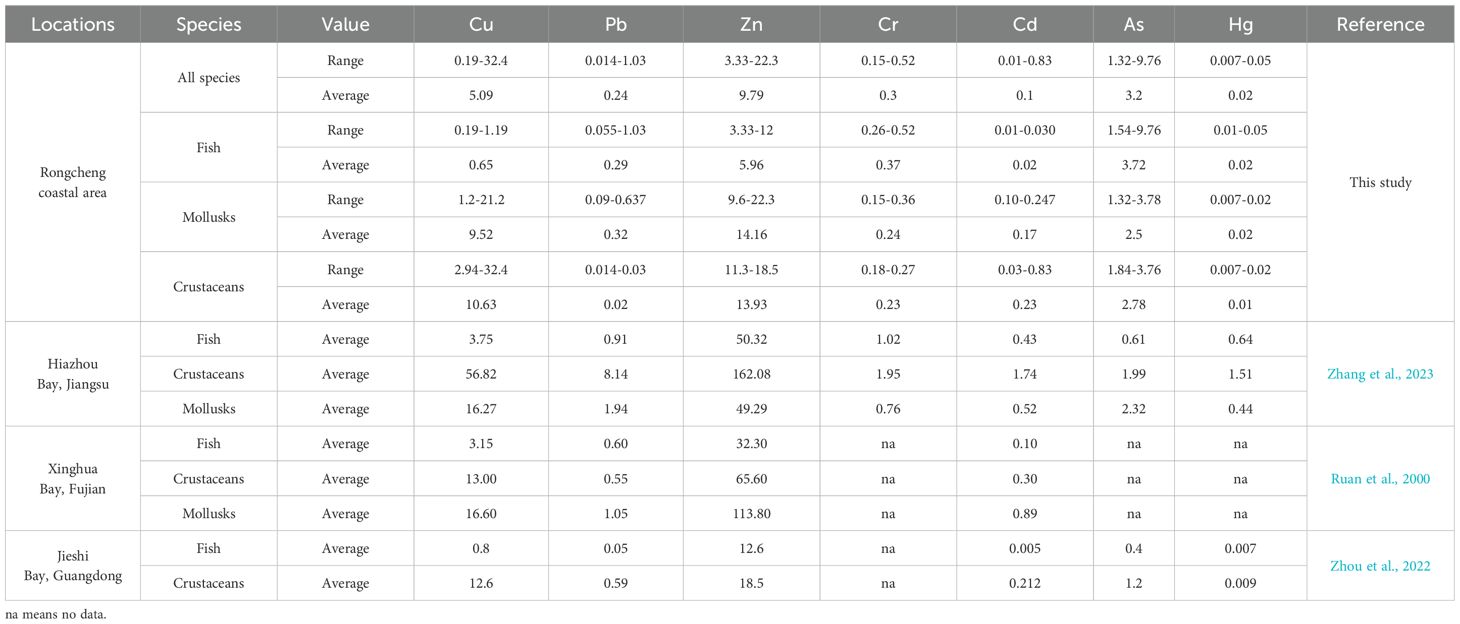
Table 7. Heavy metal(loid) concentration in marine organism in Rongcheng coastal area and other areas (unit: μg/g; wet weight).
3.5 Human health risk of heavy metal(loid)s in organisms
A certain regularity can be observed in the average content of heavy metal(loid) elements in three types of organisms in Rongcheng coastal area. Fish: Zn>As>Cu>Cr>Pb>Cd>Hg. Mollusks: Zn>Cu>As>Pb>Cr>Cd>Hg. Crustaceans: Zn>Cu>As>Cr>Cd>Pb>Hg. Zinc and copper, both essential elements in the growth and development of marine organisms, are primarily involved in the synthesis of enzymes in organisms and are highly concentrated in the organism, becoming an indispensable part of the organism. The other five heavy metal(loid) elements have a low or negligible biological demand for their harmful effects, resulting in a relatively low concentration of enrichment in the biological body. The high content of arsenic in fish may be affected by pollution.
In accordance with the biological quality standards set forth in the Concise Regulations for the Comprehensive Survey of Coastal Zone and Sea Surface Resources in China, the standard index of heavy metal(loid) content in marine organisms in the study area is presented in Table 8. The average standard index of heavy metal(loid) content in fish was As > Cu > Zn > Cd > Cr > Hg > Pb, and As and Cu at some stations exceeded the standard. The average index of heavy content in mollusks was As > Cu > Zn > Hg > Cr > Pb > Cd, and all standard indices met the standard requirements. The average standard index of heavy metal(loid) content in crustaceans was As > Cr > Cu > Cd > Zn > Hg > Pb, and each index met the standard requirements. As had the average standard index was highest in fish, mollusks, and crustaceans (0.71, 0.25, and 0.35, respectively) (Table 8). The standard indices of the remaining heavy metal(loid)s were low, indicating that they met the corresponding biological quality standards.
The capacity of marine organisms to accumulate heavy metal(loid)s was quantified using the BAF. BWAF > 1 indicates that the organism has a strong capacity for the enrichment of heavy metal(loid)s from seawater. This capacity is proportional to the value. The concentration of heavy metal(loid)s in seawater is often very low, but the pollutants in the seawater can be concentrated step by step in the higher level of organisms through the food chain (Dean et al., 2007). The results showed that the contents of heavy metal(loid)s in the surface seawaters in Rongcheng coastal area were low, but except for Pb and Cr, the BWAF values of other heavy metal(loid)s in most stations were greater than 1 (Table 9), indicating that the organisms in the study area have strong enrichment capacity of these metal(loid)s from seawater (Harada, 2016). Crustaceans and mollusks exhibited higher enrichment of Cu, Zn and Cd than fish. The ingestion of heavy metal(loid)s by crustaceans occurs through the filtration of seawater, with the concentration of heavy metal(loid)s in their tissues being significantly influenced by the habitat. The BWAF values of fish were relatively lower than those of other species, reflecting the fact that fish have a wide range of activities in water and a strong metabolic capacity (Islam and Tanaka, 2004; Hoai et al., 2020), but fish demonstrated strong enrichment of Hg in the study area.
4 Conclusion
This investigation systematically evaluated the spatial patterns and contamination characteristics of heavy metal(loid)s in both surface waters and marine organisms from Rongcheng’s coastal region. The analysis revealed distinct distribution trends among the studied elements in seawater, with Cu, Pb, Zn, and Cr demonstrating similar spatial patterns characterized by elevated concentrations in nearshore waters. Notably, all measured elements except Pb complied with the Class I water quality criteria (GB 3097-1997), though Pb exhibited concerning contamination levels, exceeding thresholds at 55% of sampling sites (moderate pollution) and 5% of sites (severe pollution). The ecological risk assessment indicated generally favorable conditions, with seawater quality maintaining clean status and posing minimal ecological threats. Source apportionment analysis identified anthropogenic activities as the primary contributors for Cu, Pb, Zn, Cr, and As, while Hg and Cd originated predominantly from natural geological processes. Biological samples displayed consistent metal accumulation patterns across different taxa: Fish: Zn > As > Cu > Cr > Pb > Cd > Hg. Mollusks: Zn > Cu > As > Pb > Cr > Cd > Hg. Crustaceans: Zn > Cu > As > Cr > Cd > Pb > Hg. Quality assessment revealed localized exceedances of safety thresholds for Cu and As in certain organisms, while other elements remained within acceptable limits. The BWAF consistently exceeded unity for most elements, demonstrating significant bioaccumulation potential in local marine species. These findings underscore the critical need for maintaining seawater quality standards to safeguard marine food resources and protect human health through seafood consumption.
Data availability statement
The raw data supporting the conclusions of this article will be made available by the authors, without undue reservation.
Author contributions
NY: Conceptualization, Funding acquisition, Investigation, Writing – original draft. CD: Data curation, Investigation, Supervision, Writing – original draft. JY: Methodology, Software, Validation, Writing – original draft. JW: Methodology, Project administration, Visualization, Writing – original draft. JF: Conceptualization, Methodology, Resources, Validation, Writing – original draft. JS: Data curation, Methodology, Project administration, Writing – original draft.
Funding
The author(s) declare that financial support was received for the research and/or publication of this article. This study is supported by the Comprehensive Geological Survey of Key Coastal Areas of Zhejiang Province (Wenzhou Key Area) Project (2018009), the Comprehensive Geological survey of Yuhuan National Marine Park (2024010) and the China Geological Survey (Nos. DD20230643 and DD20191003).
Conflict of interest
The authors declare that the research was conducted in the absence of any commercial or financial relationships that could be construed as a potential conflict of interest.
Generative AI statement
The author(s) declare that no Generative AI was used in the creation of this manuscript.
Publisher’s note
All claims expressed in this article are solely those of the authors and do not necessarily represent those of their affiliated organizations, or those of the publisher, the editors and the reviewers. Any product that may be evaluated in this article, or claim that may be made by its manufacturer, is not guaranteed or endorsed by the publisher.
References
Achary M. S., Panigrahi S., Satpathy K. K., Prabhu R. K., and Panigrahy R. C. (2016). Health risk assessment and seasonal distribution of dissolved trace metals in surface waters of Kalpakkam, southwest coast of Bay of Bengal. Reg. Stud. Mar. Sci. 6, 96–108. doi: 10.1016/j.rsma.2016.03.017
Alyazichi Y., Jones B., and Mclean T. (2015). Spatial and temporal distribution and pollution assessment of trace metals in marine sediments in Oyster Bay, NSW, Australia. Bull. Environ. Contam. Toxicolo. 94, 52–57. doi: 10.1007/s00128-014-1434-z
AQSIQ (1997). “Administration of quality supervision, inspection and quarantine of the People’s Republic of China,” in Sea Water Quality Standard (GB 3097-1997) (Standards Press of China, Beijing).
Avvari L., Basuri C., Chari H., Tirukkovalluri S., and Gollapalli N. (2022). Assessment of heavy metal distribution in seawaters of Kakinada Bay, a tropical mangrove-rich coastal environment. Mar. pollut. Bull. 181, 113877. doi: 10.1016/j.marpolbul.2022.113877
Azdem D., Mabrouki J., Moufti A., El hajjaji S., and Fatni A. (2024). Assessment of heavy metal contamination in seawater in Agadir coastline, Morocco. Mar. pollut. Sci. 317, 100129. doi: 10.1016/j.dwt.2024.100129
Caccia V., Millero F., and Palanques A. (2003). The distribution of trace metals in Florida Bay sediments. Mar. pollut. Bull. 46, 1420–1433. doi: 10.1016/S0025-326X(03)00288-1
Chatterjee M., Silva E. V., and Sarkar S. K. (2007). Distribution and possible source of trace elements in the sediment cores of a tropical macrotidal estuary and their ecotoxicological significance. Environ. Int. 33, 346–356. doi: 10.1016/j.envint.2006.11.013
Dean R. J., Shimmield T. M., and Black K. D. (2007). Copper, zinc and cadmium in marine cage fish farm sediments: an extensive survey. Environ. pollut. 145, 84–95. doi: 10.1016/j.envpol.2006.03.050
Duan Y., Pei S., Liao M., Zhai S., Zhang H., Xu G., et al. (2021). Spatial distribution of heavy metals in the surface sediments of Laizhou Bay and their sources and pollution assessment. Mar. Geol. Quat. Geol. 41, 67–81.
Gao Q., Wang N., Xiang L., and Sui Q. (2025). Distribution and pollution assessment of heavy metals in seawater, surface sediments and marine organisms in Lianyungang offshore, China. Reg Stud. Mar. Sci. 84, 104111. doi: 10.1016/j.rsma.2025.104111
Hakanson L. (1980). An ecological risk index for aquatic pollution control.a sedimentological approach. Water Res. 14, 975–1001. doi: 10.1016/0043-1354(80)90143-8
Harada Y. (2016). Determination of heavy metal concentrations in squid organs of the East China Sea and evaluation as environmental indicators. Tokyo Ocean. Univ. 4, 25–43.
Hoai N., Thanh T., Manh H., Thung D., and Johnstone R. (2020). An assessment of heavy metal contamination in the surface sediments of Ha Long Bay, Vietnam. Environ. Earth Sci. 79, 436. doi: 10.1007/s12665-020-09192-z
Islam M. S. and Tanaka M. (2004). Impacts of pollution on coastal and marine ecosystems including coastal and marine fisheries and approach for management: a review and synthesis. Mar. pollut. Bull. 48, 624–649. doi: 10.1016/j.marpolbul.2003.12.004
Küikrer S. and Mutlu E. (2019). Assessment of surface water quality using water quality index and multivariate statistical analyses in saraydüzwǔ dam lake, Turkey. Environ. Monit. Assess. 191, 1–16.
Leung H., Cheung K., Chi K., Yung K., and Li W. (2021). An assessment of heavy metal contamination in the marine soil/sediment of Coles Bay area, svalbard, and greater bay area, China: A baseline survey from a rapidly developing bay. Environ. Sci. pollut. Res. 28, 22170–22178. doi: 10.1007/s11356-021-13489-2
Lü D., Zheng B., Fang Y., Shen G., and Liu H. (2015). Distribution and pollution assessment of trace metals in seawater and sediment in Laizhou Bay. China J. Oceanol. Limnol. 33, 1053–1061. doi: 10.1007/s00343-015-4226-3
Madadi R., Mejjad N., and De-la-Torre G. E. (2023). Geochemical speciation, ecological risk, and source identification of heavy metal(loid)s in sediments and waters from Musa Estuary, Persian Gulf. Mar. pollut. Bull. 190, 114836. doi: 10.1016/j.marpolbul.2023.114836
Nour H. E., Helal S. A., and Wahab M. A. (2022). Contamination and health risk assessment of heavy metals in beach sediments of red sea and Gulf of Aqaba, Egypt. Mar. pollut. Bull. 177, 113517. doi: 10.1016/j.marpolbul.2022.113517
Pan J., Pan J. F., and Wang M. (2014). Trace elements distribution and ecological risk assessment of seawater and sediments from Dingzi Bay, Shandong Peninsula, North China. Mar. pollut. Bull. 89, 427–434. doi: 10.1016/j.marpolbul.2014.10.022
Qiu J., Yin P., Liu J., Cao K., and Wang S. (2019). Historical records of trace metals in core sediments from Jiangsu coastal are, China. Mar. pollut. Bull. 149, 110625. doi: 10.1016/j.marpolbul.2019.110625
Ramadan F., Nour H., Aita S., and Zahran H. (2021). Evaluation of heavy metals accumulation risks in water of the Qalubiya drain in East Delta, Egypt. Arab. J. Geosci. 14, 1750. doi: 10.1007/s12517-021-08198-6
Ruan J., Xu C., and Luo D. (2000). Assessment of heavy metals in sea water, suface sediments and fishery organsims at Xinghua Bay, Fujina Province. Trop. Oceanol. 19, 52–57.
Rubio B., Nombela M. A., and Vilas F. (2000). Geochemistry of major and trace elements in sediments of the Ria de Vigo (NWSpain): an assessment of metal pollution. Mar. pollut. Bull. 40, 968–980. doi: 10.1016/S0025-326X(00)00039-4
Sun Y., Huang C., Sui Q., Lou A., Xia B., Zhang X., et al. (2021). Concentration variation and pollution assessment of heavy metals in surface seawater of Sanggou bay. Mar. Environ. Sci. 40, 752–759.
Wang J., Han Z., and Wang Y. (2023). Distribution and environment assessment of heavy metals in surface sediments of the Sanggou Bay and adjacent area. Mar. Geol. Front. 39, 87–93.
Wang X., Liu L., Zhao L., Xu H., and Zhang X. (2019). Assessment of dissolved heavy metals in the Laoshan Bay, China. Mar. pollut. Bull. 149, 110608. doi: 10.1016/j.marpolbul.2019.110608
Wang X., Sui Q., Zhao X., Xia B., Chen B., and Qu K. (2022). Distribution characteristics and potential risk assessment of heavy metals in sediments from Sanggou bay, China. Mar. Environ. Sci. 41, 365–371.
Waykar B. and Petare R. (2016). Studies on monitoring the heavy metal concentrations in the water, sediment and snail species in Latipada reservoir. J. Environ. Biol. 37, 585–589.
Wu X., Xu Y., Fu X., Tang H., Wei X., and Zhu J. (2017). Contaminant characteristics and ecological risk assessment on pollution by seven heavy metals in surface sediments of adjacent waters of Ailian Bay in Rongcheng, Shandong Province. Sci. Tech. Eng. 17, 139–144.
Xavier D. D. A., dos Santos V. ,. F., de Miranda A. G., and Berredo J. F. (2020). Determination of background geochemistry of an Amazon estuary: the Cunaní Estuary- Amapa. Mar. pollut. Bull. 155, 111144. doi: 10.1016/j.marpolbul.2020.111144
Xiang L., Jiang S., Cheng H., Wang Y., Liu Q., Yin Y., et al. (2023). Heavy metal concentration profiles and pollution assessment in the Jiangsu offshore area, China. Mar. pollut. Bull. 193, 115187. doi: 10.1016/j.marpolbul.2023.115187
Xu Y., Gao H., Wei X., and Zhu J. (2021). Heavy metals and their ecological risk in the surface sediments of Laizhou Bay. Period. Ocean Uni. China 51, 74–85.
Yue N., Xiong C., Zhang Y., Zhang W., Feng Y., Li X., et al. (2024). Environmental quality assessment of heavy metals in the Rongcheng offshore area, Shandong Peninsula, China. Mar. pollut. Bull. 199, 116018. doi: 10.1016/j.marpolbul.2023.116018
Zhang S., Fu K., Gao S., Liang B., and Fu G. (2023). Bioaccumulation of heavy metals in the water, sediment, and organisms from the sea ranching areas of Haizhou Bay in China. Water 15, 2218. doi: 10.3390/w15122218
Zhou W., Cao Q., Hong M., Lei Y., Wen D., and Zhang D. (2022). Spatial distribution and risk assessment of heavy metals in seawater and sediments in Jieshi Bay, Shanwei, China. Front. Mar. Sci. 9, 1011564. doi: 10.3389/fmars.2022.1011564
Keywords: Shandong Peninsula, heavy metal(loid)s, pollution status, sources, ecological risk
Citation: Yue N, Dong C, Yang J, Wang J, Feng J and Sun J (2025) Distribution and pollution assessment of heavy metal(loid)s in seawater and organisms in Rongcheng coastal area, China. Front. Mar. Sci. 12:1583535. doi: 10.3389/fmars.2025.1583535
Received: 26 February 2025; Accepted: 27 May 2025;
Published: 17 June 2025.
Edited by:
Lixin Pei, The University of Melbourne, AustraliaReviewed by:
Youssef Lahbib, Tunis University, TunisiaLevent Bat, Sinop University, Türkiye
Xiaoyan Wang, Zhejiang Ocean University, China
Copyright © 2025 Yue, Dong, Yang, Wang, Feng and Sun. This is an open-access article distributed under the terms of the Creative Commons Attribution License (CC BY). The use, distribution or reproduction in other forums is permitted, provided the original author(s) and the copyright owner(s) are credited and that the original publication in this journal is cited, in accordance with accepted academic practice. No use, distribution or reproduction is permitted which does not comply with these terms.
*Correspondence: Jing Feng, ZmVuZ2ppbmcyMDAyNzJAMTYzLmNvbQ==; Jing Sun, d2h4ZG1haWxAMTYzLmNvbQ==
 Nana Yue1
Nana Yue1 Chao Dong
Chao Dong Jing Feng
Jing Feng


